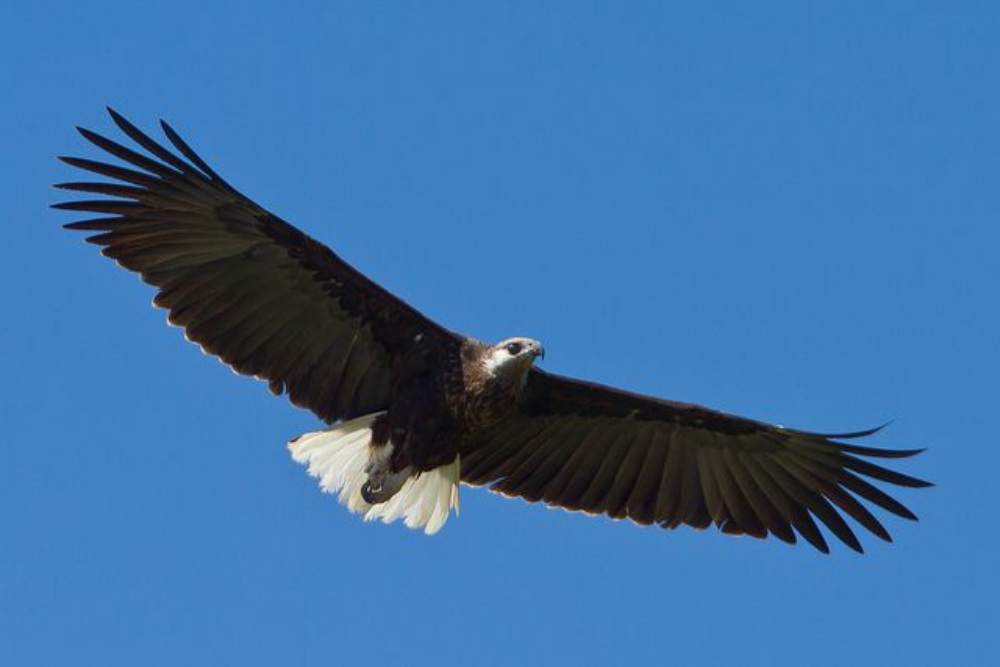In the vast wilderness of Madagascar, amidst its unique biodiversity, resides a majestic avian monarch – the Madagascar Fish Eagle (Haliaeetus vociferoides). Endemic to the island, this raptor stands as a symbol of resilience, adaptation, and the challenges faced by Madagascar’s rich yet fragile ecosystems. In this article, we delve into the fascinating world of the Madagascar Fish Eagle, exploring its biology, habitat, conservation status, and the imperative need to safeguard its existence.
Biology and Appearance of the Madagascar Fish Eagle
The Madagascar Fish Eagle is a formidable bird of prey, boasting a wingspan of up to 6 feet (1.8 meters) and weighing around 3 to 4 kilograms. Its plumage is predominantly brown, with a distinctive white head and neck, and a hooked yellow beak perfectly evolved for hunting. Its piercing golden eyes reflect its prowess as a skilled hunter, primarily feeding on fish, hence its name.
Habitat and Distribution
This magnificent eagle primarily inhabits the wetlands, mangroves, and coastal regions of Madagascar, favoring serene lakes, rivers, and estuaries where it can easily hunt its preferred prey. Its distribution is limited to specific areas across the island, including the northeastern and western regions, making it an iconic symbol of Madagascar’s natural heritage.
Behavior and Ecology
As a top predator in its ecosystem, the Madagascar Fish Eagle plays a crucial role in maintaining the ecological balance of its habitat. Its hunting technique involves soaring high above the water, keenly observing for fish near the surface, before swooping down with remarkable speed and accuracy to snatch its prey with its powerful talons.

Breeding and Reproduction of Madagascar Fish Eagle
During the breeding season, which typically occurs from April to October, these eagles engage in elaborate courtship displays, including aerial acrobatics and vocalizations. They construct large nests atop tall trees near water bodies, where the female lays a single egg. Both parents participate in incubating the egg and raising the chick, demonstrating a strong bond and cooperative parenting.
Conservation Status and Threats
Despite its iconic status, the Madagascar Fish Eagle faces numerous threats to its survival, primarily stemming from habitat loss, degradation, and human activities such as deforestation, pollution, and unsustainable fishing practices. The conversion of wetlands for agricultural purposes and the construction of dams further exacerbate the challenges faced by this vulnerable species.
Conservation Efforts for Madagascar Fish Eagle
Efforts to conserve this eagle breed and its habitat have gained momentum in recent years, with initiatives focusing on habitat restoration, community engagement, and raising awareness about the importance of preserving Madagascar’s unique biodiversity. Moreover, conservation organizations collaborate with local communities, government agencies, and international partners to implement sustainable practices and mitigate threats to the species’ survival.
Future Perspectives
The future of these Eagles hinges upon our collective commitment to conservation efforts and the sustainable management of its fragile habitats. Through continued research, monitoring, and also adaptive management strategies, we can ensure that future generations have the privilege of witnessing the soaring majesty of this remarkable bird in Madagascar’s wild landscapes.
Conclusion
In the intricate tapestry of Madagascar’s natural heritage, the Madagascar Fish Eagle stands as a poignant reminder of the delicate balance between human development and the preservation of biodiversity. Its resilience in the face of adversity inspires us to strive for a harmonious coexistence with nature, where the survival of every species, no matter how grand or humble, is valued and also safeguarded for generations to come. Let us unite in our efforts to protect the Madagascar Fish Eagle and preserve the rich ecological legacy of this enchanting island paradise.









